#Best Time of The Year to Visit Tanzania
Explore tagged Tumblr posts
Text
Explore The Best Time to Visit Tanzania With Our Travel Experts

Planning a trip to Tanzania? And wondering what time of the year is the Best Time to Visit Tanzania? Tanzania is great to visit almost any time of the year.
But when is the Best Time of The Year to Visit Tanzania? Well, the answer depends on your interests and the experiences you seek. In this post, we’ll break it down month by month to help you plan the perfect Safari In Tanzania.
Tanzania is an all-year destination. However, from June to October (the dry season) is usually the best time to visit. This is because the foliage is less thick and it is easier to spot wildlife. The Great Wildebeest Migration is in Tanzania (Serengeti) for 8 months of the year, and usually, the best time to see it is in June – July. If you wish to see the calving season, January to early March is the best time to visit (Ndutu area).
Month By Month Guide To Travelling In Tanzania
June to October – Dry Season: These are the Best Month For Tanzania Safari to see the wildebeest migration
August to September is the best time to see the wildebeest river crossings in northern Serengeti. Animals are easier to spot since they concentrate around waterholes and rivers
January-February is the time to see the calving in the southern Serengeti, and an excellent time to see predator action
March to May is the peak of the Wet season. Wildlife viewing in Tarangire, Katavi, Selous, and Ruaha is better during the Dry season
Now that you know When the Best Time to Visit Tanzania is, it’s time to plan your dream safari or cultural adventure. If you’re passionate about preserving this stunning natural beauty for future generations and want to make a positive impact on the environment and local communities, consider booking your trip with Sumbi Extra Miles Safari.
So start planning your amazing Tanzania Safari Vacations with today! We provide the best customized and tailored packages and Tanzania Travel Guide which suits your needs and interests to make your trip successful.
#Best Time of The Year to Visit Tanzania#Safari In Tanzania#Best Time to Visit Tanzania#Tanzania Safari Vacations
0 notes
Text
The Best Time to Embark on an Unforgettable Tanzanian Adventure
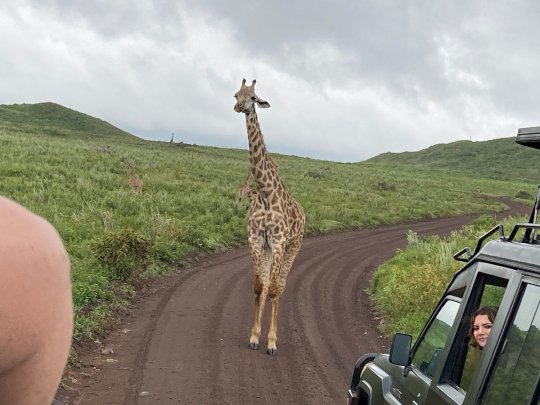
Tanzania, a land of diverse landscapes and abundant wildlife, offers a magical experience for travellers seeking a memorable African adventure. Choosing the Best Time To Visit Tanzania is crucial to ensure you witness its natural wonders at their finest. In this guide, we'll explore the different seasons in Tanzania and help you discover the Best Time Of Year To Safari In Tanzania to plan your safari or climb the majestic Mount Kilimanjaro.
1. Dry Season (May to October)
The dry season is considered the best time to visit Tanzania, offering favorable conditions for wildlife safaris and outdoor activities. From May to October, the weather is generally dry and cool, providing comfortable temperatures during the day and chilly nights. This season marks the Great Migration in Serengeti, as millions of wildebeest, zebras, and other herbivores move in search of water and fresh grazing lands, attracting predators in their wake. Witnessing this incredible spectacle is a once-in-a-lifetime experience.
The dry season also presents an excellent time for mountain climbing, particularly for ascending Mount Kilimanjaro. The clear skies offer breathtaking views, and the dry trails make the trek safer and more manageable. It's essential to book accommodations and tours well in advance, as this period attracts a considerable number of tourists.
2. Wet Season (November to April)
The wet season in Tanzania, from November to April, is characterized by occasional heavy rains. While this season might not be the ideal time for safari adventures, it brings its own unique charm to the country. The landscapes transform into lush greenery, and many animals give birth during this time, leading to an abundance of young wildlife.
In the southern and western parts of Tanzania, such as the Selous Game Reserve and Katavi National Park, the wet season offers fantastic opportunities for birdwatching, as migratory birds arrive in large numbers. Additionally, this period sees fewer tourists, providing a more exclusive and tranquil experience.
However, it's essential to note that some roads might become impassable due to flooding, and certain remote areas might be inaccessible during heavy rains. Despite this, the wet season can still be a rewarding time to visit Tanzania if you're interested in birdlife and can tolerate occasional showers.
3. Shoulder Seasons (April to May and November)
The transitional months of April to May and November are considered the shoulder seasons, marking the periods between the wet and dry seasons. During these months, tourism is at its lowest, and accommodations often offer discounted rates. While there is a higher chance of rainfall during these periods, it can vary from year to year. Travellers who prefer quieter experiences and are willing to take a bit of a risk with the weather might find these months suitable for your best Tanzania Experience.
Conclusion
Choosing the Best Time To Visit Tanzania largely depends on your preferences and interests. If you seek the thrill of witnessing the Great Migration and exploring Tanzania's wildlife in its natural habitats, the dry season is ideal. On the other hand, the wet season offers its own unique rewards for travellers seeking a more exclusive experience. Whether you're a wildlife enthusiast or an adventurer set to conquer Mount Kilimanjaro, Tanzania Safari Holidays promises an unforgettable journey in every season.
#Best Time To Visit Tanzania#Tanzania Safari Holidays#Tanzania Experience#Best Time Of Year To Safari In Tanzania
1 note
·
View note
Note
it's kinda interesting to me that you never remember barbados. one of my friends is from barbados which makes it one of the more significant countries to me, so i'll never forget it in a world map or armericas map. yeah i just think it's interesting which 'obscure' countries some people always remember or forget
oh 100%. for me i always remember angola because a kid from there came to visit our class once. same with tanzania, one of my friends in primary school lived there for some years, so i could pick it out on a blind map every time.
there's a lot of 'obscure' countries a lot of people forget about because it's not relevant to them, but at the same time it means home to hundreds of thousands, and for many others it's "my best friend is from there :)" or "i visited on vacation and it was the best time in my life" or a hundred other small things. and idk man just thinking about it fills me with a sense of wonder. i ❤️ the world.
#and i know hungary is the obscure country for many people lol#but yeah it's personally very important to me to know at least a little bit about every country#i could meet someone from barbados any time. i should know where it is at the very least#i just don't wanna be ignorant about any place that means the world to someone else if you get it
8 notes
·
View notes
Text
Three Incredible African Safari Destinations

Africa is a famous vacation spot, with millions of tourists visiting the continent yearly to go on safari, a word in Swahili meaning trip. Visitors who go on safari have the opportunity to see a wide variety of wild animals in their natural habitat. Among the many safari destinations, Kenya, Tanzania, and South Africa are considered to be the best places to experience the beauty and splendor of the African wilderness.
For good reason, Kenya has long been regarded as the birthplace of the safari. It is home to the world-renowned Maasai Mara National Reserve, which gives tourists the chance to see the "Big Five" (elephant, buffalo, rhinoceros, lion, and leopard) and other wildlife including giraffes, hippos, and hyenas in one location. The Mara's diverse topography, from expansive savannahs to green riverine forests, provides the perfect backdrop for wildlife observation and photography.
The best time to go on safari in Kenya is during the dry season, which runs from July to October. This is when the spectacular Great Migration takes place, with over 1.5 million zebras, gazelles, and wildebeest moving from Tanzania's Serengeti National Park to Kenya's Maasai Mara in search of greener pasture. To reach the Maasai Mara during the Great Migration—which is recognized as one of the world's new wonders—the animals have to swim across the Mara River, which is packed with crocodiles, and sadly, many of them do not make it through the crossing. Predators such as lions, cheetahs, and leopards that lurk in the Maasai Mara still pose a threat to those animals that survive the Mara River crossing. Every year, thousands of visitors travel to Kenya and its neighbor Tanzania to witness the Great Migration.
Between July and October, travelers to Tanzania can also be a part of the Great Migration at the popular Serengeti National Park, which rivals Kenya's Maasai Mara in terms of natural beauty and wildlife. Tanzania is also home to the Ngorongoro Crater, a UNESCO World Heritage that hosts thousands of wild animals, including a large population of lions, elephants, wildebeest, and rhinos, making it one of the most densely populated wildlife areas in the world.
Another must-see destination in Tanzania is Mount Kilimanjaro, Africa's tallest peak. While not a traditional safari location, the iconic mountain adds to Tanzania's allure, offering opportunities for trekking and stunning panoramic views of the surrounding landscapes. Travelers interested in a more cultural experience can also interact with the Maasai people, a nomadic tribe living in Tanzania and Kenya who have rich traditions and a strong bond with the land and wildlife.
In South Africa, a well-liked safari attraction is Kruger National Park. This park is one of Africa's largest wildlife sanctuaries, spanning around 20,000 square kilometers. More than 500 bird species and 147 mammal species call it home, and many of the Big Five animals can also be spotted by visitors at Kruger National Park. The ideal time to go on safari at Kruger is also during South Africa's dry season, from April to October. At this time, animals congregate around waterholes and are easier to find because of the scant vegetation.
South Africa provides opportunities to visit wineries, seaside towns, and historical places like Nelson Mandela's jail cell at Robben Island, Cape Town, for people who want to mix a safari with other pursuits.
5 notes
·
View notes
Text






























National Smile Day
Wear your best smile to this party as we celebrate National Smile Day every year on May 31. Founded by dentists Dr. Tim Stirneman and Jim Wojdyla of Compassionate Dental Care in Lake in the Hills, Illinois, this day is meant to, you guessed it, “Share with the world what the power of a healthy smile can do!” The best part, this day heralds the beginning of National Smile Month!
History of National Smile Day
The history of the smile can be traced back to monkeys and apes, according to primatologist Signe Preuschoft. These animals bare their teeth in a facsimile of a smile to show dominance or warn off predators. The theory is that humans copied this behavior and, over time, the smile evolved to show amusement and enjoyment. Research indicates that on the way to portraying happiness, smiles were a way of attracting mates among early humans.
If you’ve ever wondered why older portraits often showed unsmiling people, it was because people in that era had a lot of tooth rot caused by sugar and a poor diet. Plus, more common was the aristocratic perception that smiling and laughing was indecorous, and showed a lack of self-control or good manners. One of the few exceptions was Leonardo da Vinci’s “Mona Lisa,” although the portrait’s ambiguity is part of its fame. As dentistry and an attitude of authenticity developed, people began smiling even in portraits, this time with their teeth on display.
Studies of yearbook photographs over the years point to the breadth of smiles increasing over the years. The study indicates that because participants had to hold the pose for longer periods in the earlier days of photography, their smiles gradually dimmed. The prevalence of smiling in the recent past is linked to culture and traditions and varies from country to country. Some regions with high individualism and low population density had a higher incidence of people who smiled. A study found that the biggest reason people smile, however, can be attributed to a country’s tradition of diverse immigration over time. So places like Brazil and the United States, where people do not share common customs or languages, see higher incidences of smiles. The study states that this is because the smile is part of a universal language.
A French neurologist, Guillaume Duchenne, who studied the mechanism of facial expression, discovered there are two types of smiles: a Duchenne smile and a non-Duchenne smile. The former smiles with the eyes or is a genuine smile, whereas the latter is an ambiguous, non-genuine, or simply polite smile.
National Smile Day timeline
1700–1780s The French Now Smile with their Teeth
French portraits of people show smiles with teeth, which is a new occurrence.
1702 Rules of Decorum Still Frown on Smiles
French priest and educational reformer Jean-Baptiste de La Salle publishes “Rules of Christian Decorum and Civility,” which advises against smiling and laughing, since they are ‘indecorous’ displays of emotion, according to him.
18th Century Dentistry Emerges in France
This is a turning point in social practices.
1950s Smiles are Common in Portraits
It becomes the norm to smile in photographs.
1962 Laughter is Contagious
In Tanzania, students at a school break out into fits of uncontrollable laughter, which eventually spreads to their parents and their acquaintances.
How To Celebrate National Smile Day
Smile!
Make someone else smile
Visit your dentist
The best way to celebrate this day dedicated to smiling is to smile, of course! Spread some good cheer around and grace another person with your smile. We often don't realize that we wear a frown for most of the day. Share a smile with someone just for a moment and see the difference it makes in your everyday interactions.
Do one thing to bring a smile to someone else’s face. Start small (tell them a joke) or go big (volunteer at a children’s home). Whatever you choose, cherish the feeling of being able to light up someone’s life, and keep bringing smiles to everyone you meet.
Since this day was created by dentists, delight yours by giving them a visit. Go for a dental checkup to make sure your smile is in tip-top shape.
5 Fun Facts About Smiling
Smiling is less taxing than frowning
Babies are better at smiling than you are
Babies can fake it too!
We know when a smile is fake
Laughing for the heck of it
It takes more muscles to frown than it does to smile.
Babies smile about 400 times a day, while, on average, adults only smile about 20 times.
At only nine or 10 months of age, babies have learned to offer fake smiles to strangers, reserving real smiles and laughter for people they are comfortable with.
Our brains have evolved to such an extent that we can see a fake smile a mile away — also, our brains automatically mimic the smile we see, which means we give a fake smile for a fake smile.
A study on why people laugh found that 80-90% of all laughter is in response to simple statements like “It was nice meeting you”, or “I’ll see you later.”
Why We Love National Smile Day
Smiles hold power!
Smiles have health benefits too
A smile is the best accessory
Not only do they automatically make you feel good (yes, even fake smiles!), but they also create a temporary bond between the people sharing a smile. Data shows that over time, smiles can increase productivity and creativity in workers, and make people seem more competent and trustworthy.
The more we smile, the healthier our brains become. This is because smiles make us happy, thus reducing stress. Smiles are also known to reduce our blood pressure, heart rate, and pain. Smiling can increase endurance, strengthen our immune system, and even help keep the cells in our body healthy.
Smiling shifts our mood, tipping it into the ‘happy’ side. A happy person is a more confident person. Walking into a room with a smile is better than wearing fancy brand-name clothes or shoes. There’s no downside to smiling, not in the way it looks, nor the results it brings us.
Source
#National Smile Day#NationalSmileDay#indoors#outdoors#cityscape#USA#landscape#California#Morro Bay#Beringer Vineyards#Freemark Abbey Winery#Napa Valley#Nevada#Colorado#Utah#travel#vacation#original photography#31 May#tourist attraction#landmark#St. Helena#British Columbia#Yukon#Alberta#Alaska#Canada#2023
2 notes
·
View notes
Text
Find the perfect Tanzania Zanzibar adventure with Zanzibar Bookings!
Are you searching for the ultimate active adventure in Zanzibar? Are you a thrill seeker, beach lover, or culture enthusiast looking to participate in multi-day adventure activities in Zanzibar? Take the help of Zanzibar Bookings – a leading travel agent based in Zanzibar. They can organize numerous day trips & adventure tours covering all alternatives Zanzibar has to offer. They bring endless opportunities for you to explore while in Zanzibar! You’re sure to find the perfect Tanzania Zanzibar adventure with Zanzibar Bookings!

Zanzibar offers a lot of excitement for those who love adventure. Along with many other activities in Zanzibar, there are thrilling activities that will challenge you. Choose to show off your daring side by opting for the best of adventures in Zanzibar. The adventure tours in Zanzibar from Zanzibar Bookings will leave you with a memorable experience! From adrenaline-fuelled experiences to water sports, there are numerous tailor-made adventures to choose from. Some of them are:
Catamaran Trip Tour organisers have a wide range of trips onboard catamarans to cater to the preferences of individual customers. A customised live aboard 50ft (16.5m) catamaran specialising in diving is based in Zanzibar, available for day sailing or longer trips. Guests can choose where they want to go and what they want to do.
Quad biking Driving a quad bike to enjoy a rich off-road itinerary into the wild landscape through local farms, sugar cane plantations, quarries, spice trees and secular baobabs. The quad bikes are very easy and safe to drive as they are fully automatic.
Fly Board
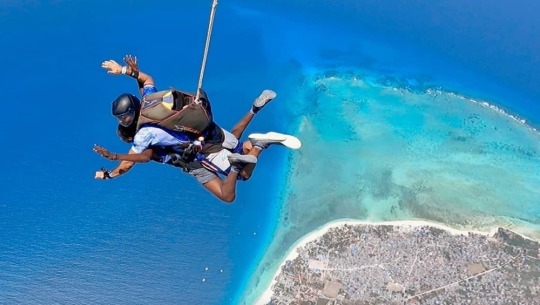
Parasailing Parasailing is a safe, easy and exciting activity. It's an adventure anyone can enjoy because there is no running or jumping, and no experience is necessary. Your captain will provide safety and flying instructions to ensure you have a wonderful time in the safest way possible. When it is your turn to parasail, you will be secured in a safety harness. You are safely and securely attached to the rope allowing you to soar in the air and enjoy the thrill of flying and the amazing panoramic views of the island.
Deep Sea Fishing Fishing in Zanzibar is a pleasure, with the turquoise and deep blue of the ocean contrasting against perfect powder blue skies. Zanzibar is famous worldwide for its exciting fishing opportunities. The water at Zanzibar is perfect for big game fishing. Whatever time of year you visit, fishing here ensures to have a great day out. Striped, black and blue marlin, elusive spearfish, Dorado, yellowfin tuna, wahoo, barracuda, and kingfish all provide endless hours of action-packed game fishing out on the ocean.
Jetski Tours The jetski tours will take you to admire its perfectly pristine setting. It will let you swim and get a chance to cruise along the coastline. If you are visiting Zanzibar and like to have some adventure, you should try this activity!
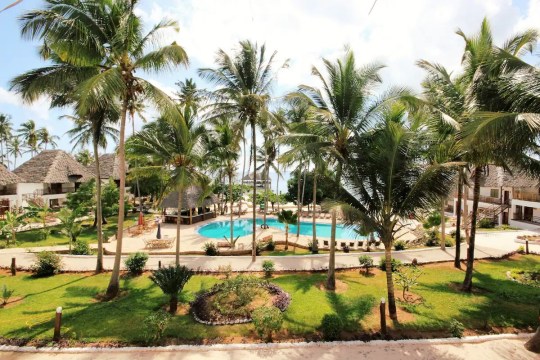
Stand Up Paddling Looking for a fun activity during your stay in Zanzibar? Joining Surf for a trip will be something you will enjoy. Whether you are a kite surfer waiting for wind or just a visitor, this is the thing for you! Stand-up Paddling is a very relaxing and fun way to enjoy the water.
Diving And Snorkelling In Zanzibar Zanzibar Island is surrounded by the warm waters of the equator. The coral reefs are home to amazing marine life and offer thrilling scuba diving and snorkelling opportunities within a short boat ride from most beaches. The safe calm waters of Zanzibar are perfect for scuba beginners!
3 notes
·
View notes
Text
A Serengeti balloon safari is a fantastic once in a lifetime experience, particularly suitable for a bird’s eye-view game viewing experience on your www.kim.tours wildlife tour in northern Tanzania. Hot air balloon rides leave from three sites in this prime national park. In Central Serengeti, wildlife gathers year-round in the Seronera River Valley where there is permanent water. The Great Migration passes through around May and June.
The plains of the Serengeti are particularly suited to balloon flights which are particularly convenient, letting you get aerially closer and distinctly accessible to the action than you could be by a game-viewing safari vehicle (read more www.kim.tours on when is the best time to visit Serengeti).
Conditions are favorable early every morning, but you are advised to pre-book this popular activity for your safari holiday to East Africa due its limited seating availability. Unfortunately, only children over seven year, old and fit and active adults can be accommodated. Because weight is a crucial safety consideration, passengers weighing over 120 kilos (265 pounds) may need to reserve two places.
The Western Serengeti includes the Grumeti River, scene of theatrical crossings during the Great Migration in June and July, when hundreds of thousands of gnu, brave the giant Nile crocodiles, and many perish while others detour to avoid the perilous river. In South Serengeti plains, the wildebeests assemble from December onwards, to calve in February, producing 8000 newborn every day on a three-week marathon, a sight not to be missed on your personalized nature travel in Serengeti.
The balloons are immense. Baskets are compartmented for comfort and security, accommodating 16 people for each one-hour voyage. The price reflects the enormous cost of the balloons due to a safety replacement every few hundred hours, equivalent to swapping with a high-end automobile.
🎈Are you ready for Africa Wildlife Experience, get in touch with us via DM and we will help plan this bucket list adventure.
Please just write as shortly your inquiry we will respond back to You as soon as possible. 📧 [email protected] | www.kim.tours | +255 768512626
5 notes
·
View notes
Photo

How to choose the best safari destinations in the world
I’m sure most of you will agree with me when I say going on a safari is the epitome of an adventurous holiday. It’s the go-to for many travellers, including families, couples, groups, and even solo travellers. Yes, a safari holiday is a once-in-a-lifetime opportunity and one of life’s greatest adventures; we decided to help you how to choose the best safari destinations in the world for you.
Our guide on how to find the best safari destinations in the world
The world is your oyster when it comes to the available choices of endless safari destinations. From self-drive safaris and fly-in safaris to guided safaris, each experience is diverse in its own way.
There are many steps to consider when planning and choosing the best safari destinations in the world. This includes many elements, such as deciding what you want to see, your mode of travel, and your budget.
Keep reading this article to find out the different options on offer so you can decide on the best safari destinations in the world that suit your personal preferences.
Choose the right time of the year to go
Although going on safari is an all-year-round activity, you may want to do some thorough research about the best time to visit the best safari destinations in the world. As you may learn, certain seasons in certain countries or regions are better than others for encountering diverse wildlife.
Decide what you want to see
There are plenty of safari destinations in the world with the natural habitats of so many types of wildlife. If you’re determined to tick off a particular type, such as the Big Five, from your list, you’ll have the best chance in Kruger National Park, one of the best safari destinations in Africa, or Masai Mara, one of the best safari parks in Kenya. Or if you want to witness the great wildebeest migration in Serengeti, Tanzania.
Decide which part of the world is the best place for a safari
Countries across the world are rife with incredible natural landscapes, giving you a vast range when it comes to choosing the best safari destinations in the world with stunning scenery and fascinating wildlife.
Make a to-do list of experiences when you’re at these safari destinations
There’s so much to see and do when it comes to going on a holiday at the best safari destinations in the world. To make your holiday a success, you have to decide exactly what kind of experience you need before you book your holiday.
Decide on your mode of transport
The most traditional way to safari is, of course, in an open-sided 4×4 Jeep. However, if you’re looking for a unique way to travel, try out a water safari which is usually conducted in a small boat or canoe. Maybe you could even choose a walking safari, which is a wonderful way of experiencing the wilderness up close and personal. However, this may become a factor in choosing the best place for a safari.
Decide on how you are going to travel or with whom
It all boils down to this, whether you are travelling solo, as a part of a group, as a couple or as a family. You have to decide on your level of independence while on a safari getaway. There are plenty of benefits and drawbacks to each option, and deciding which option suits you are a crucial matter when choosing the best safari destinations in the world.
The best safari destinations in the world
So, you want to go on a safari getaway at one of the top safari destinations in the world while experiencing the thrill of getting up close and personal with wild animals in their natural habitat.
But what safari destinations should you choose?
With a plethora of species of birds and mammals in more than 6,000 national parks across the globe, choosing the best safari destinations in the world can be a daunting task.
So, to make things easy for you, we’ve come up with a list of top safari destinations in the world where you can have your ultimate wildlife adventure.
Let’s dive in
What are the best safari destinations in Africa?
Haven’t you dreamed of going on a safari in Africa? The African continent has inspired many travellers (including myself) to want to see wild animals on their own turf and to experience the cultural diversity Africa has to offer.
Let’s take a look at the best safari destination in Africa that you could choose from:
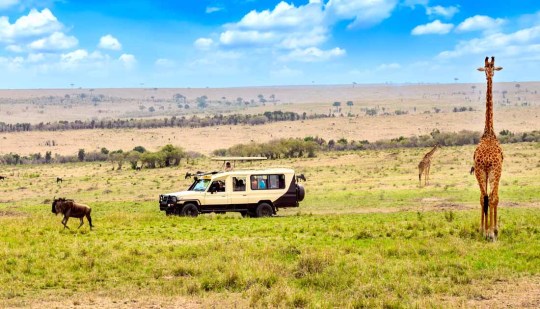
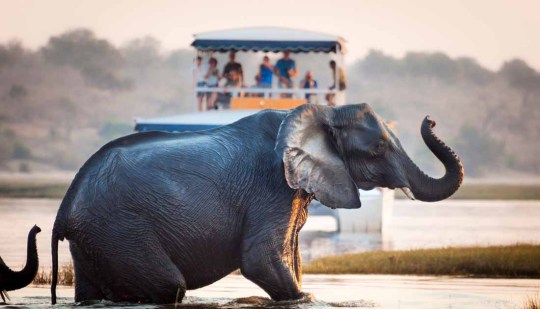
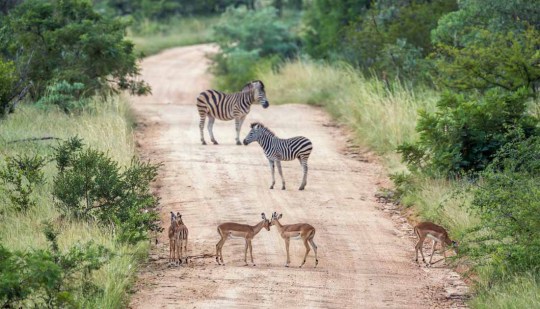
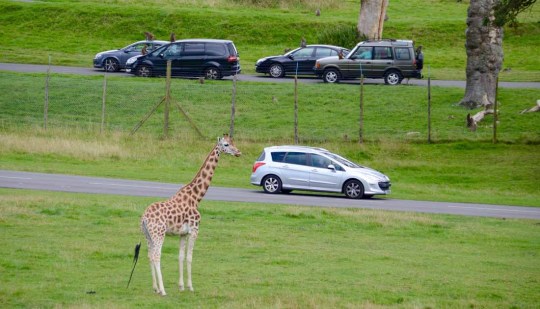
1. Maasai Mara National Reserve, Kenya
Maasai Mara is always at the top of the list of safari destinations when talking about the best safari destination in Africa. This premier national park offers everything you could want in a safari. It is a wildlife enthusiast’s dream come true. It’s also one of the best places to visit in Africa if you want to see the Big Five and is considered one of the best safari parks in Kenya.
2. Chobe National Park, Botswana
One of the best safari destinations in the world, Chobe National Park is Botswana’s first and most diverse national park sits in Africa. Commonly known as the “Land of the Giants,” this beautiful park is home to over 120,000 elephants, which is Africa’s largest elephant population. But, that’s not all; there are many other species you can see in their natural habitat too.
3. Kruger National Park, South Africa
To me, Kruger National Park is definitely one of the best safari destination in Africa as it is renowned for having the best safaris in South Africa with lush views and is also one of Africa’s largest game reserves.
4. Serengeti National Park, Tanzania
An African wildlife safari? It has to be the Serengeti. Well, at least for many of us! This is the place where you’ll find the most varied collection of wildlife on earth and one of the places where the great migration of over one million wildebeest and 200,000 zebras come south for the rain before heading northwest. This crown jewel is the ultimate safari destination and one of the best safari destinations in the world, without a doubt.
Best places for a safari in Asia
Apart from the gargantuan African continent, some other parts of our planet offer a range of unique flora and fauna. And Asia, being the largest continent, is definitely home to thousands of species of wildlife, on land and water! Speaking of, Asia hosts a number of National Parks and Reserves to ensure a natural habitat for animals, making it one of the best safari destinations in the world.
If you’re thinking of jumping on the next plane to one of the best places for a safari in Asia, take a pick from these safari destinations in Asia and prepare to be fascinated!





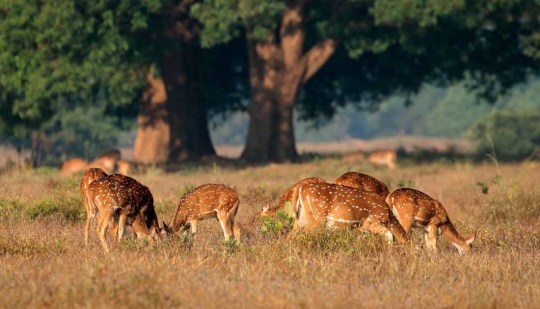
1. Cardamom Mountains
The Cardamom Mountains, located in Cambodia, are one of the most plentiful rainforests in entire Southeast Asia and one of the best safari destinations in the world. You’ll be completely impressed by the Indochinese tigers, clouded leopards, black bears, wild Asian elephants, and over 450 species of birds.
Next on our list of the top safari destinations in the world is the Komodo National Park in Indonesia, one of the best places for a safari that is unique.
2. Komodo National Park
Indonesia is a gorgeous country rich in culture and wildlife, such as giant lizards or “Komodo Dragons,” which are seen only on this part of the island. This makes it one of the most unique and best safari destinations in the world!
For the best safari in the world, check out this next destination.
3. Taman Negara National Park
The largest park in Malaysia, Taman Negara National Park, is absolutely one of the best places for a safari. With untouched rainforests, a range of flora and fauna such as rhinoceros, tigers, Asian elephants, macaques, clouded leopards, and more! This destination also has many other activities such as hiking and rock climbing.
Now, we’ll take a look at Ba Be National Park in Vietnam, undoubtedly one of the best safari destinations in the world.
4. Ba Be National Park
Nature-lovers rejoice! This is yet again one of the most unique and best safari parks in the world, where you’ll be allured by the lushness of the evergreen forests of Ba Be National Park. This place has the lowest human contact, which means that the wildlife here flourishes in its natural habitat. Here you can witness a rare variety of animals like the Vietnamese Salamander, Chinese pangolins, red giant flying squirrels, and Tonkin snub-nosed langur monkeys. That’s not all; you’ll be able to see a varied species of bats in the caves!
5. Yala National Park
Sri Lanka is home to many beautiful landscapes and many safari destinations. Renown as the largest and most popular as one of the best safari destinations in the world. This place is the ideal spot to see the Sri Lankan leopard, 32 other species of mammals, 125 species of birds, and even elephants.
There’s no way you should miss this on your next wildlife adventure in Asia. Kanha National Park, in India. One of the best safari parks in the world!
6. Kanha National Park
With a diverse landscape that includes thick evergreen forests, ravines, lush meadows, and Kanha gorges, this place is touted as the most scenic safari destination in Asia. Home to several species of birds and unique animals such as the barasingha and swamp deer.
7. Shuklaphanta Wildlife Reserve
The Shuklaphanta Wildlife reserve in Nepal is a vast and open grassland covered by the Sal Forest. However, this place is still widely off the radar for travellers, making it the perfect place if you want to see animals in their natural habitat. But, if you should make it here, you might be lucky to get close encounters with the royal Bengal tiger, the great one-horn rhinoceros, hog deer, barking deer, and more!
Which is the best safari park in UK?
Which is the best safari park in the UK? Well, that’s an easy question (or is it?) Finding the best safari park in the UK is no easy task. While an African or Asian safari may be on most people’s travel bucket lists, there are places for wildlife viewings closer to home.

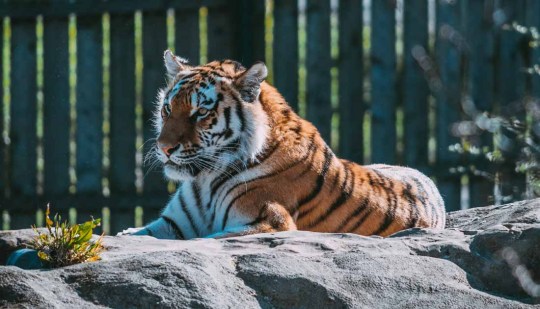

1. Longleat Safari Park
Located in the South West of England, this top-tier park offers a wonderful experience. There is a variety of animals, including wolves, rhinos, cheetahs, tigers, lions, an elephant, gorillas, and more!
Next on the list of the best safari park in the UK is ..
2. Blair Drummond Safari Park
Blair Drummond Safari Park is an unforgettable attraction that is home to many animals, including lions, elephants, giraffes, and meerkats. This has been one of the top safari destinations in the UK since it opened in 1970.
Up next for the best safari park in the UK is..
3. Port Lympne Wild Animal Park
Get up close and personal with a range of animals, that’s more than 90 species who thrive across 600 giant acres. Here, you’ll see endangered species, the black rhinos, the documented single largest herd.
That’s not all; you will see three more popular safari parks in the UK :
West Midland Safari Park
Knowsley Safari Park
Woburn Safari Park
Which is the best safari park in the UK? Well, you decide!
For more blogs click here
#travel#wildlife#safari#wanderlust#exploretheworld#explore#placestovisit#traveller#holiday destinations#mustvisit#travelbucketlist#travelcenteruk#travelcenterblog
5 notes
·
View notes
Photo
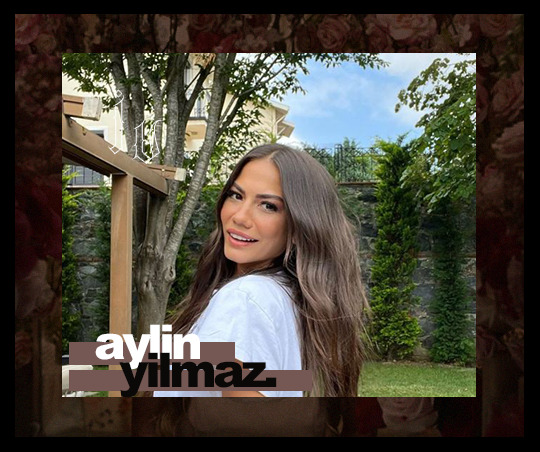
[ demet ozdemir, female, she/her ] - was that AYLIN YILMAZ i saw by the lighthouse today? i heard that the THIRTY ONE year old who has been in nightrest for ON AND OFF HER ENTIRE LIFE and works as an OWNER OF TWO DOGS VETERINARY has a reputation of being COMPASSIONATE, but also BLUNT. they reside in LOW POINT & people in town usually associate them with THE SMELL OF FRESH CUT LILACS, LONG WAVY CHOCOLATE BROWN HAIR AND ALMOST ALWAYS AROUND ANIMALS . let’s hope the killer doesn’t go after them next
𝐁𝐀𝐒𝐈𝐂𝐒 …
𝐅𝐔𝐋𝐋 𝐍𝐀𝐌𝐄: aylin yilmaz 𝐍𝐈𝐂𝐊𝐍𝐀𝐌𝐄(𝐒): ali ( friends and family only ) 𝐏𝐑𝐄𝐅𝐄𝐑𝐑𝐄𝐃 𝐍𝐀𝐌𝐄(𝐒): aylin 𝐁𝐈𝐑𝐓𝐇 𝐃𝐀𝐓𝐄: april 16th, 1992 𝐀𝐆𝐄: 31 years old 𝐆𝐄𝐍𝐃𝐄𝐑: female 𝐏𝐑𝐎𝐍𝐎𝐔𝐍𝐒: she/her 𝐑𝐎𝐌𝐀𝐍𝐓𝐈𝐂 𝐎𝐑𝐈𝐄𝐍𝐓𝐀𝐓𝐈𝐎𝐍: heteromantic 𝐒𝐄𝐗𝐔𝐀𝐋 𝐎𝐑𝐈𝐄𝐍𝐓𝐀𝐓𝐈𝐎𝐍: heterosexual 𝐂𝐇𝐈𝐋𝐃𝐑𝐄𝐍: none
𝐁𝐈𝐎𝐆𝐑𝐀𝐏𝐇𝐘…
born april 16, 1992, aylins life from the time she was born was never going to be a normal one. with her dad in the army, it was to be assumed that she would never be in one place for long. at the time of her birth, her father had been deployed, with him not returning home until she was one year old. by the time he did come home, the family had gotten orders to relocate to fort bragg. following the orders, the family moved down to fort bragg. for the first few years of her life, the family lived there. though when aylins mother got the call that her great grandmother had fallen ill, aylin, her mother and siblings moved back to nightrest while her father stayed at fort bragg.
on the weekends, her father did visit. growing up, she had come used to that. to her father not being around as much. a year after moving back to nightrest, her great grandmother had passed away. though she was young at the time, she knew how much her great grandmother had missed her great grandfather who had passed away a few years earlier. to her, it was clear she had passed on due to a broken heart. but she didn't voice that she believed that. instead, she let the adults believe what ever they had said. after her death, aylins mother kept them in nightrest. it was a talk her mother had with her father. and keeping them there was the best decision over all. it meant not moving as often. though despite that, aylin made sure to split her time between fort bragg and nightrest.
during the holidays, and summer vacation, she would spend it with her father on base. as she would spend her time there during breaks and the summer, she did end up making friends there too. it was during this time that aylin took a liking to animals. and helping them too. the summer before her senior year of high school. she found a stray puppy that she eventually took in. naming her kiara, she helped nurse her new puppy back to help with the guidance of the local vet near fort bragg. returning home towards the end of summer, her mother was surprised with the fact that she had a dog. but in no time came to love her just as much.
following graduation, and spending the summer there, she packed her bags and headed off to cornell university in new york. for four years, she studied there before applying to the veterinary school of medicine there. getting accepted, she spent four more years there. during her years it veterinarian school. aside from going for surgery, she took up two specialties which was a rare thing. aquatic animal medicine and feline medicine. the summer before her final year, she spent it in Northern Tanzania at the Serengeti National Park there. it was there that she helped nurse back to health a lioness and her cubs. in the process, forming a bond with the mother lioness. to say it hurt when she had to leave was an understatement. returning to new york, she finished her final year of school before graduating.
returning home, she moved back in with her mom before getting a job at the veterinarian clinic. it was also around this time that she learned her dad had changed to the massachusetts national guard. which meant he would be home more often. two years after getting her job, the keys to the place were given to her, followed by the ownership of it. which surprised her. owning the place was a shock. never did she think she would become the owner of the place. but she had. and she would take it with pride.
flash forward to now, from time to time, she does tend to go travel. mainly to africa to the same wildlife conservation she went to years ago. though now with the recent killings, leaving home has been put on hold. how could she even leave her family when all hell was starting to break loose?
OTHER FACTS…
- she tends to like animals more mainly because a.) they don't talk back and b.) they don't start any drama with anyone.
-she's been in a few relationships over the years. one of them ended pretty bad while the others ended on a good note.
- after a few months of living with her parents, she eventually ended up getting her own place in low point. she has considered moving though but is picky on what kind of house she wants.
WANTED CONNECTIONS…
her person: a childhood friend of hers, this person knows her in and out. they’re also joined by the hip as well. and when all hell breaks loose, these two are always by each others side to help the other get through it. ( can be male or female)
childhood friends: a group of friends she’s known since she was a kid. ones who will almost always get together once a week.
- first love/high school sweet heart: this was her first everything and the only guy she really ever loved. they broke up whether they stayed in touch afterwards is up to the person who takes this up. and whether they're still close as well. they could still have feelings for each other too.
3 notes
·
View notes
Text
3 Days Tanzania Zanzibar tour flying to Serengeti

Travel Company: DAV Safaris
Website: www.davsafaris.com
Email:[email protected]
Tel: +256757795781 or +256701412430
This 3-day Tanzania Zanzibar tour package is the best and most convenient flying safari itinerary starting from Zanzibar to Serengeti national park and Ngorongoro crater and flying out to Zanzibar, allowing you to experience the best of both worlds on a luxury Tanzania safari in a single Tanzania safari trip, This Tanzania Zanzibar tour combines the stunning beaches of Zanzibar island with the incredible wildlife of the Serengeti like the big fives lions, elephants, leopards and buffaloes and other wildlife like Wildebeests, Zebras and giraffes that that are hard to miss on any Serengeti tour in Tanzania and also check for missed wildlife in Ngorongoro craters
This 3-day Tanzania Zanzibar tour itinerary is ideal for travelers eager to experience the Big Five and diverse wildlife while enjoying a Zanzibar beach vacation. It’s designed for those who want a thrilling safari experience without dedicating too much time away from the stunning shores of Zanzibar. Perfect for those who value both relaxation and adventure, this package ensures you maximize your wildlife encounters while still soaking up the sun on beautiful beaches. This 3-day Tanzania Zanzibar tour can be organized to you at any time of the year, best time for beach holidays and best month to visit Tanzania Serengeti is typically falls during the dry season, ideal for wildlife watching and beach activities.
This 3-day Tanzania Zanzibar tour can be adjusted or customized according to your Tanzania vacation request and preferences on number of days accommodations, activities and other special interests
Tour highlights
Day 1: Fly from Zanzibar to Serengeti National Park
Day 2: Serengeti National Park to Ngorongoro Conservation Area
Day 3: Ngorongoro Crater transfer to Arusha Airport back to Zanzibar
Price Includes:
Lodge as specified in the itinerary
All meals included at the Camps and packed lunch box
Experienced English speaking guide
Unlimited kms, Toyota Land Cruiser 4×4 Safari vehicle with pop up roof, 6 window seats, power adapters, and refrigerator
Drinking water
Domestic flight (to Zanzibar)
All park entry fees and 18% VAT
Price Excludes:
International Flights
Visa
Medications
Medical / Travel Insurance
Optional activities such as Hot Air Balloon Rides
Alcoholic and soft drinks
Additional night after Safari and Airport transfer the next day is $ 100 pp
Tip for Your Driver ($70 per day per car)
0 notes
Text
Best African Safari Destinations for Wildlife Enthusiasts
For cheap and best Travel Bookings - https://tripsdeals.com/
Embarking on an African safari is a dream adventure for wildlife enthusiasts seeking thrilling encounters with nature's most majestic creatures. Africa, with its diverse ecosystems and rich biodiversity, offers an unparalleled experience for travelers. Here are some of the best African safari destinations that promise unforgettable wildlife experiences:
1. Serengeti National Park, Tanzania Home to the legendary Great Migration, Serengeti National Park is a must-visit for anyone who loves wildlife. Witness millions of wildebeests, zebras, and gazelles moving across the plains, closely followed by predators like lions and cheetahs. The Serengeti's vast landscapes provide year-round game-viewing opportunities.
2. Maasai Mara National Reserve, Kenya The Maasai Mara, an extension of Tanzania's Serengeti, is renowned for its abundant wildlife and the iconic Great Migration. Its open savannahs are perfect for spotting the Big Five—lion, leopard, elephant, rhinoceros, and buffalo—as well as witnessing thrilling predator-prey interactions.
3. Kruger National Park, South Africa Kruger National Park is one of Africa’s largest game reserves, offering excellent self-drive safari options. With a network of roads and luxurious lodges, visitors can explore its diverse wildlife, including elephants, giraffes, hippos, and a wide variety of bird species.
4. Okavango Delta, Botswana The Okavango Delta is a unique safari destination where you can explore the wilderness by traditional mokoro (dugout canoe). Its waterways and islands are teeming with elephants, hippos, crocodiles, and an array of birdlife, making it a paradise for nature lovers.
5. Etosha National Park, Namibia Etosha National Park is famous for its striking salt pans and abundant wildlife that congregates around its waterholes. Spot lions, leopards, elephants, and endangered species like the black rhino in this breathtaking landscape.
6. Bwindi Impenetrable Forest, Uganda For a unique safari experience, head to Bwindi to track mountain gorillas. This UNESCO World Heritage Site is home to half of the world’s remaining gorilla population and offers an intimate encounter with these gentle giants in their natural habitat.
Africa’s safari destinations offer experiences that range from adrenaline-filled game drives to serene wildlife encounters. Whether you’re a first-time visitor or a seasoned explorer, these locations promise memories that will last a lifetime.
#AfricanSafari#BestSafariDestinations#WildlifeTravel#SerengetiNationalPark#MasaiMara#KrugerNationalPark#OkavangoDelta#EtoshaNationalPark#BwindiGorillaTracking#TravelAfrica#BudgetSafari
0 notes
Text
Experience Pemba Island: A 2025 Guide to Diving and Snorkeling Bliss

Pemba Island, situated just north of Zanzibar, is a hidden paradise for diving and snorkelling lovers. Renowned for its pristine coral reefs, crystal-clear waters, and diverse marine life, Pemba offers an ideal escape for underwater exploration. If you're planning your next Zanzibar Beach Holiday, make sure Pemba Island is on your list. With its serene beaches and thriving marine ecosystem, it's the ultimate spot for water sports enthusiasts seeking an unforgettable experience.
Before immersing yourself in Pemba’s underwater treasures, take time to enjoy its breathtaking beaches. Renowned as some of the most pristine in Zanzibar, these beaches feature powdery white sand, swaying palm trees, and crystal-clear turquoise waters. Thanks to Pemba’s seclusion, you’ll often find these serene stretches of shoreline entirely to yourself, offering a tranquil escape into nature. Whether you're taking a leisurely walk along the shore or soaking in the peaceful atmosphere, Pemba’s beaches are nothing short of paradise.
The Beauty of Pemba Island’s Beaches
Before diving into Pemba’s marine wonders, take a moment to appreciate the beauty of its beaches. The island is home to some of the most pristine Beaches In Zanzibar, with powdery white sand, lush palm trees, and turquoise waters.
Pemba’s secluded nature means you’ll often have these beaches all to yourself, allowing for an intimate connection with nature.
Whether you're strolling along the shore or enjoying the peaceful ambience, Pemba’s beaches are a true paradise.
Pemba Island provides the perfect blend of relaxation and adventure. While its Beaches Zanzibar are perfect for unwinding, its underwater world offers some of the best diving and snorkelling in the region. Whether you're an avid diver, a casual snorkeler, or someone who simply loves exploring tropical paradises, Pemba Island offers something for everyone.
For your next Tanzania Zanzibar Beach Holiday, consider visiting Pemba Island with Halisia Afrika. With its quiet beaches, rich marine life, and unforgettable diving and snorkelling experiences, it’s a destination you’ll want to return to year after year.
Want to know more details, visit this blog @ https://halisiaafrica.com/blog/a-2025-guide-to-pemba-islands-best-diving-and-snorkelling-spots/
0 notes
Text
What to know about the Top 11 Safari Destinations in Kenya for an Incredible Wildlife Experience?
Discover why Saudi Arabia is emerging as a top global business hub in 2024. Explore its thriving economy, Vision 2030 reforms, strategic location, and investment opportunities driving innovation and growth.
Kenya is renowned for its breathtaking landscapes, abundant wildlife, and unforgettable safari adventures. This guide explores the top 11 safari destinations in Kenya, offering insights into their unique features and what makes them must-visit locations. From the iconic Maasai Mara, known for the Great Migration, to the remote and stunning Samburu National Reserve, each destination presents a unique chance to witness Africa's majestic wildlife in its natural habitat. Whether you're eager to spot the Big Five, experience rich Maasai culture, or enjoy luxury lodges amidst the wilderness, Kenya's safari destinations promise an incredible adventure.

11 Premier Safari Destinations to Visit in Kenya
Offer an unparalleled adventure for travelers seeking to experience the continent's stunning wildlife and landscapes. Kenya is renowned for its world-famous Maasai Mara National Reserve, where visitors can witness the awe-inspiring Great Migration, one of nature's most incredible spectacles. Whether you prefer luxurious lodges or rustic camping under the stars, safari in Kenya cater to all tastes, and offer a truly magical experience. Offering the opportunity to connect with the rich cultural heritage of communities like the Samburu, who warmly welcome visitors and share their traditions. From thrilling game drives to serene hot air balloon rides over the savannah, these safaris promise unforgettable moments.
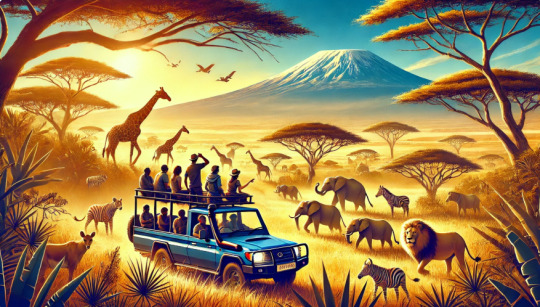
Where can you find the best wildlife safaris?
It’s time to end the confusion and start the journey on a real adventure. Kenya is the ultimate destination for having an unforgettable safari experience. From the iconic Big Five to lesser-known hidden gems, Kenya’s safari destinations will provide memories that will last forever.
11 Unmissable Safari Destinations to Explore in Kenya
1. Exploring the Wonders of Masai Mara National Reserve
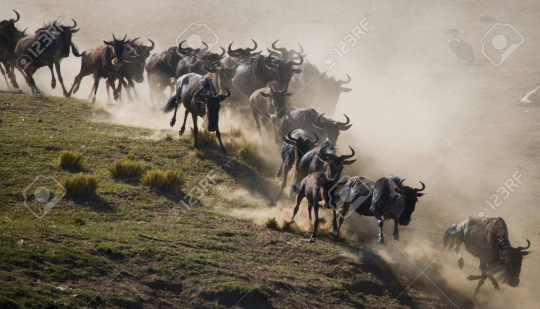
The Masai Mara, located in southwestern Kenya along the border of Tanzania’s Serengeti National Park, is Kenya’s top safari destination. It offers incredible wildlife experiences, from sightings of majestic big cats, elephants, rhinos, and buffalo to the world-famous Wildebeest Migration. Each year, from July to October, millions of wildebeest and other grazers make a daring crossing of the Mara River from the Serengeti in search of greener pastures, making it one of the most thrilling spectacles in the reserve. The Masai Mara should be your top choice for a truly unforgettable safari in Kenya.
Category : Details :
Best Time to Visit - June to October
How to Reach - A 40-minute flight from Nairobi or by road
The table shows data for animal migration numbers from July to October 2023.
Name of Animals : Migratory Number :
Zebras - 4,000,000
Wildebeest - 1,500,000
Gazelles - 3,000,000
Eland - 12,000
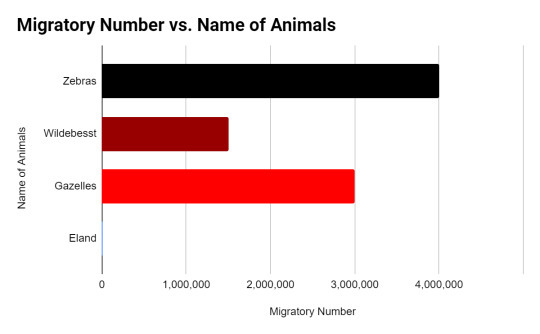
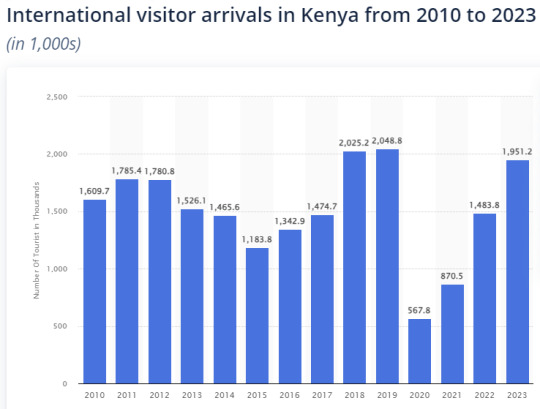
2. Exploring the Wonders of Lake Nakuru National Park

Lake Nakuru Wildlife Haven: Flamingos, Rhinos, and Scenic Beauty
A haven for flamingos and rhinos, this park offers great views for birdwatching and wildlife viewing. Admire the rift valley escarpment, expansive lake, and Euphorbia-dotted savannah. Spot lions, leopards, impalas, antelopes, bushbucks, and baboons. Enjoy camping, lodges, and delicious cuisine.
Although flamingo and pelican numbers have declined, Lake Nakuru remains a rhino sanctuary and a hotspot for birdlife. Explore the forested Flamingo Hill for lion sightings.
This park, 170 kilometres northwest of Nairobi, captures the essence of Africa with its diverse wildlife and breathtaking landscapes.
Category: Details:
Best Time to Visit - All year long
How to Reach - 3 hour drive from Nairobi
Type Of Rhinos: Population:
White Rhinos - 120
Black Rhinos - 30
Total - 150
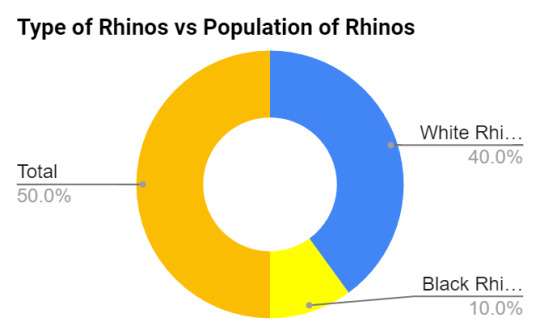
3. Discover the Wonders of Samburu National Reserve
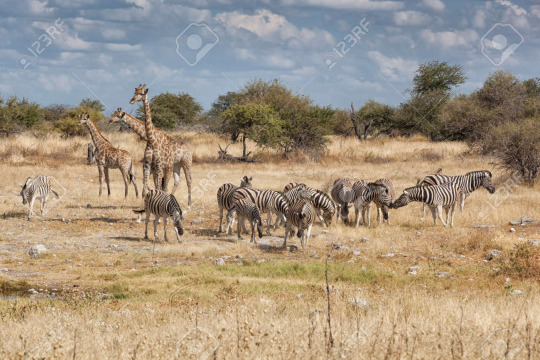
The Samburu National Park takes its name from the Samburu tribe, who have lived in this region for many generations. Though smaller in size when compared to famous parks like the Masai Mara, the Samburu National Reserve is teeming with wildlife.
Category: Details:
Best Time to Visit - June to October
How to Reach - Daily flights from Nairobi or a full-day drive
4. Exploring the Wonders of Mount Kenya National Park
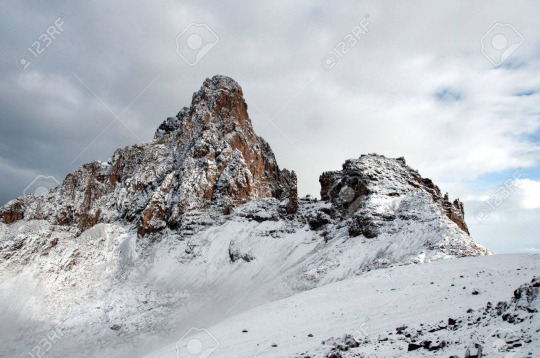
Known for its amazing landscapes, incredible biodiversity, and unique wildlife, Mount Kenya National Park is considered one of Kenya’s most extraordinary parks. It is Africa's second-highest mountain, only surpassed by Kilimanjaro, with a summit elevation of 5,200m above sea level. Mount Kenya National Park's centre location is significant not only as a natural phenomenon but also culturally and historically significant.
a. Discover the Natural Wonders of Mount Kenya National Park: Wildlife and Scenic Views
Mount Kenya National Park is located on Mount Kenya, the highest mountain in Kenya and the second-highest in Africa. The park has a magnificent view of Mount Kenya in the background and its surrounding scenery, which features bamboo and African rosewood forests. Visitors may encounter diverse wildlife such as elephants, leopards, duikers, elands, waterbucks, and giant forest hogs.
b. Explore the Rich Biodiversity and Birdlife of Mount Kenya National Park
Bird lovers will be thrilled to discover over 130 recorded bird species within the park. A safari here provides hiking, sightseeing, nature walks, game drives, and birdwatching opportunities.
c. Experience the Rare Landscapes Of Mount Kenya
The park is home to many rare and unique flora and fauna, including majestic elephants, elegant giraffes, elusive leopards, and playful chimpanzees. The park’s landscapes are equally stunning, from the rugged peaks of Mount Kenya to the gentle hills, grasslands, and valleys at lower altitudes. If you're planning a visit to Kenya, be sure to take the opportunity to experience the stunning beauty of Mount Kenya National Park!
Category: Details:
Best Time to Visit - June to September.
How to Reach - The closest airport to Mount Kenya National Park is Nairobi Wilson (WIL).
5. Discover the Wonders of Nairobi National Park
(Female lion walking in a grassy field during the daytime in Nairobi National Park)
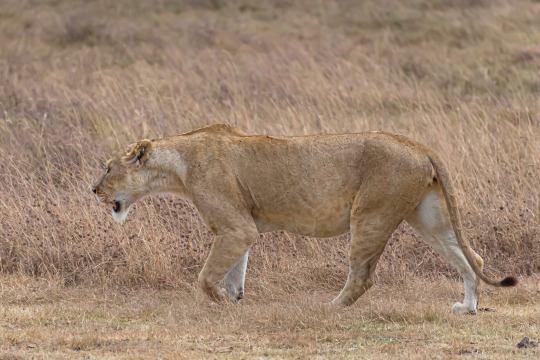
a. Encounter Urban WildLife At Nairobi National Park
A city-centre oasis located in the southern part of the city, this park offers thrilling game drives and peaceful safari walks. Spot buffalos, lions, gazelles, zebras, giraffes, leopards, warthogs.
The park is known for its diversified terrain, exclusive wildlife, and impressive views. The park is spread over an area of 117 acres. It’s the perfect place to spot the Big Five, with over 300 bird species. Explore its open savannahs, dense forests, and water bodies. Discover historical sites like the Nairobi National Museum and Nairobi Animal Village.
The park is a must-visit place for wildlife explorers seeking an unforgettable adventure.
Category: Details:
Time to Visit - The dry season is ideal for wildlife viewing (July- March)
How to Reach - The distance from Nairobi Airport (NBO) to Nairobi National Park is 15 km by road.
6. Exploring the Beauty of Amboseli National Park
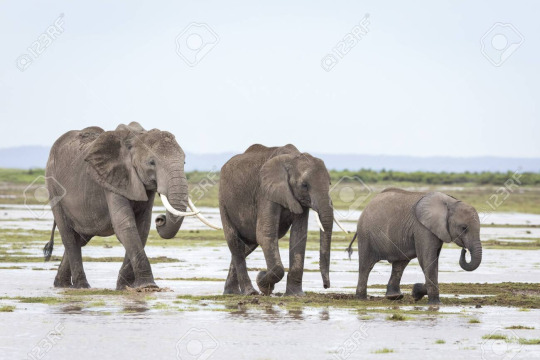
a. Amboseli National Park The Territory of Elephants
Amboseli National Park, commonly called “Territory For Elephants”, is a famous safari destination in Kenya. Located in the southern region of the country. The park is famous for two reasons: firstly, having the largest herds of elephants, and secondly having a scenic view of Mt. Kilimanjaro.
b. Explore the Diverse Wildlife and Culture in Amboseli Nature Park
The park also got 5 hot spots with habitats that attract visitors, including Lake Amboseli's dry bed, expansive savannahs, dense woodlands, and wetlands fed by sulfur springs. Amboseli Park also provides an opportunity to interact with the Masai people and learn about their cultural practices.
c. Seeing The Serene Beauty Of Amboseli: A Kilimanjaro Sunrise
The main highlight of Amboseli National Park is the stunning view of Mount Kilimanjaro. Early morning people can easily enjoy the morning view of the mountain as the mountain rises from the morning mist, thus offering a breathtaking sight. While admiring this natural wonder, visitors may also encounter some of the giant tusked elephants grazing peacefully at the foot of the mountain. The park is home to 370 bird species and renowned African animals like zebras, wildebeest, lions, cheetahs, giraffes, buffaloes, warthogs, impalas, jackals, and leopards.
Category: Details:
Best Time to Visit - June to October
How to Reach - A four-hour drive or a short flight from Nairobi.
7. Discover the Wonders of Tsavo National Park
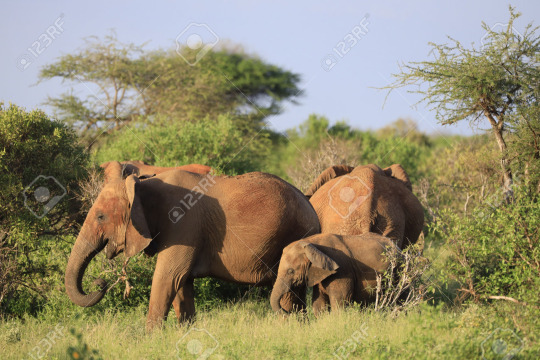
Tsavo National Park, located near Voi town in Taita-Taveta County, is one of Kenya's oldest and largest national parks, covering 13,747 square kilometres. It is divided into parts: Tsavo East and Tsavo West.
a. Tsavo East
Tsavo East is known for the Big Four (elephant, lion, leopard, and buffalo). The park is known for spotting elephants, and you’ll commonly find them bathing in red soil for their reddish appearance. Tsavo is also eminently known for its diversified wildlife species, including rhinos, buffaloes, lions, leopards, hippos, crocodiles, waterbucks, oryxes, gerenuks, lesser kudus, cheetahs, giraffes, vervet monkeys, and over 500 bird species.
b. Tsavo West
Tsavo West offers a more secluded experience with features like Mzima Springs, where you can observe hippos and crocodiles. Tsavo’s vast wilderness provides a unique and remote safari experience, with iconic sights like elephants in the Galana River and the famous baobab and doum palm trees in Tsavo East.
Category: Details:
Best Time to Visit - May to October
How to Reach - You can drive 10 hours from Nairobi or take a convenient charter flight.
8. Exploring Meru National Park
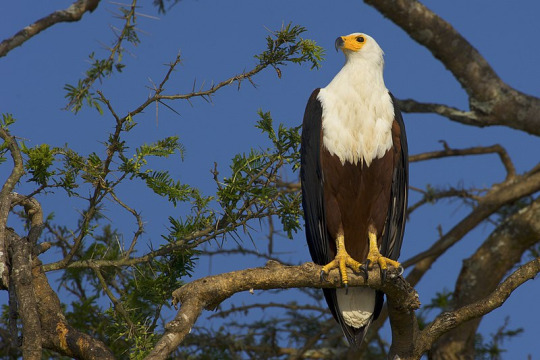
Nestled 350 km east of Nairobi, Meru National Park is a lesser-known yet captivating Kenyan gem. Its expansive, untouched grasslands, rolling hills, and riverine habitats offer a sanctuary for diverse wildlife.
a. Explore Meru’s Rich Biodiversity
Spot reedbucks, gazelles, zebras, giraffes, hartebeests, elephants, lions, leopards, hyenas, cheetahs, hippos, crocodiles, and jackals. Bird enthusiasts can identify over 427 species, while snake lovers may encounter pythons, cobras, puff adders, and more.
b. A New Era in Meru National Park
After a period of decline, Meru has rebounded. The park covers 870 square kilometres for exploring the wilderness, providing excellent views for game viewing. The Big Five, cheetahs, and savannah species are increasingly common. The park's waterways offer opportunities to observe hippos, crocodiles, and the iconic African fish eagle.
Category: Details:
Best Time to Visit - July to October
How to Reach - Drive from Nairobi (NBO) to Meru National Park, which takes approximately 5 hours and 32 minutes.
Must-See Attractions in Meru National Park
Category: Details:
🌿 A Legacy of Conservation - Once home to Joy, George Adamson, and the legendary Elsa the lioness.
🏞️ Scenic Beauty - Enjoy breathtaking views of Mount Kenya.
🏞️Diverse Habitats - Explore rivers, riverine habitats, the Tana
River, and Adamson's Falls.
🐾Wildlife Galore - Spot Grevy's zebras, elephants, eland, bush
pigs, waterbucks, cheetahs, leopards,
reticulated giraffes, hippos, bohor,
reedbucks, hartebeests, pythons, puff
adders, cobras, buffaloes, and more.
🐦Birdwatcher's Paradise - Observe over 427 recorded bird species.
🌳Varied Vegetation - Discover thorny bushland, wooded
grasslands, open grasslands, and dense riverine forests.
9. Discover Aberdare National Park
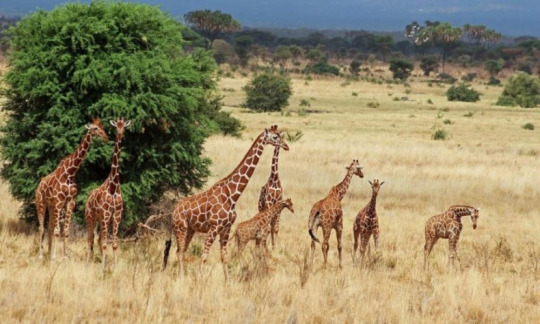
Geographically located within the Aberdare Mountain ranges the park has rugged terrain consisting of steep, afforested greens, gorges and vast grasslands. Aberdare National Park has diversified wildlife animals: elephants, black rhinos, spotted hyenas, buffaloes, warthogs, leopards, olive baboons, and black and white colobus monkeys. Furthermore, wildlife explorers can get a chance to encounter African golden cats, several cats, civet cats,blue-duikers, Giant Forest hogs and Bongos.
a. Destination For Bird Lovers
Aberdare National Park is also famous for its bird population, with over 250 recorded species. Notable among these are sparrowhawks, sunbirds, plovers, and eagles, along with many others.
Category: Details:
Best Time to Visit - January, February, June, and September
How to Reach - The park is located 180 km north of Nairobi.
10. Exploring Laikipia
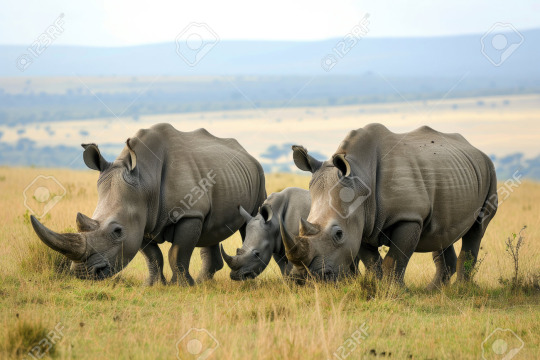
Laikipia, located in the northwestern zone of Mount Kenya, is steadily becoming one of Kenya’s top safari destinations. The area is scantily populated; Laikipia has immense landscapes with immaculate wilderness and unmatched views. Laikipia is home to a maximum number of endangered mammals compared to any part of East Africa after the Masai Mara region.
Laikipia also has a dense population of unique species like the Grevy zebra and reticulated giraffe. The main highlight of this region is the rhino population, which accounts 50% of Kenya’s total rhino count.More than 300 rhinos roam freely in the vast plains, Lakipia has turned out to be a safe haven for these endangered animals.
Category: Details:
Best Time to Visit - July to October
How to Reach - Visitors can take private charters from Nairobi or other parks. Alternatively, charter flights are available from Nanyuki, the nearest town.
11. Exploring the Kenyan Coastline
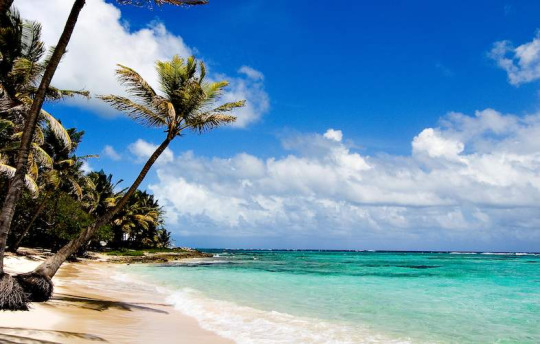
a. Sun, Sea And Safari: The Kenyan Coastline
Kenya’s coastline is a popular safari destination, featuring beautiful beaches and tropical waters protected by a coral reef near Mombasa. On this coastal paradise, travellers can do various activities, such as snorkelling, fishing, swimming, scuba diving, and kite surfing, making it a popular choice for families, holidaymakers, adventure enthusiasts, and honeymooners. The Kenyan coastline is the perfect destination for having a remarkable safari experience in East Africa combining safari experience.
b. White Sands And Blue Waters: Diani Beach
One of the main attractions along the beach is Diani Beach, located about 19 kilometers south of Fort Jesus on safaris from Mombasa. Diani is famous for its white, pristine sandy beaches, as well as the fascinating Wasini Island and Wasini Marine National Park to the south. Additionally, Diani is one of Africa's top snorkeling destinations, offering an exceptional underwater experience.
Category: Details:
Best Time to Visit - October to January
Frequently Asked Question
Can I combine a beach holiday with a safari in Kenya?
Kenya offers a unique opportunity to combine a beach holiday with a safari in Kenya easily. The Kenyan coastline offers beautiful beaches and a variety of water activities.
How can a traveller have a cultural experience in Kenya?
The interaction with Maasai communities to learn about their traditions and customs can provide a cultural experience to the traveller by visiting historical sites.
a. What is the best way to spot wildlife on a safari in Kenya?
Be patient, quiet, and observant. Early morning and late afternoon are often the best times for wildlife sightings.
b. What should I pack for a safari in Kenya?
Pack comfortable clothing, sturdy shoes, a hat, sunscreen, insect repellent, and binoculars.
c. What is the best way to travel between safari destinations in Kenya?
The most common ways to travel between safari destinations are by road or air. Many safari lodges offer internal flights or transfers.
d. Are there any family-friendly safari destinations in Kenya?
Many safari destinations in Kenya are suitable for families with children. Look for lodges that offer family-friendly activities and amenities.
e. What are some of the cultural experiences I can have in Kenya?
You can interact with Maasai communities, learn about traditional Kenyan customs, and visit historical sites.
#travel#travelling#parks in kenya#kenya#safari in kenya#wildlifeparkinkenya#nationalparksofkenya#safariparksinkenya
0 notes
Text
How to Find a Reputable Tanzania Tour Operator for Your Dream Safari
Planning a safari in Tanzania is a once-in-a-lifetime adventure. From the sweeping plains of the Serengeti to the majestic peaks of Mount Kilimanjaro and the breathtaking beauty of Ngorongoro Crater, Tanzania offers some of the most iconic safari experiences in the world. However, the success of your journey largely depends on the expertise of your tour operator. Choosing a reputable Tanzania tour operator ensures a seamless, enjoyable, and stress-free experience. Here’s a guide to help you make the right choice for your dream safari.
1. Research Online and Read Reviews

2. Look for Local Expertise
Choosing a tour operator based in Tanzania offers numerous advantages. Local companies have intimate knowledge of the country’s terrain, wildlife, and cultural nuances. They are better equipped to handle logistical challenges and provide authentic experiences. A tour operator in Tanzania often works with experienced guides who understand animal behavior and know the best times and places to maximize your sightings.
3. Verify Certifications and Memberships
A reputable tour operator is usually certified by relevant tourism authorities and is a member of professional associations such as the Tanzania Association of Tour Operators (TATO). These memberships indicate that the operator adheres to industry standards and best practices. Additionally, such operators are often committed to sustainable tourism practices that benefit local communities and preserve the environment.
4. Ask About Customization Options
Not all safari-goers have the same preferences. While some may want an adventure-packed experience in Serengeti National Park, others may prefer a more leisurely exploration of Tarangire or Lake Manyara. The best Tanzania safari tour operators offer customizable packages tailored to your specific interests, budget, and travel dates. They will take the time to understand your needs and create an itinerary that aligns with your expectations.
5. Assess Transparency in Pricing
Beware of operators who provide vague or overly low price estimates. A reputable operator will be upfront about costs and include details such as park fees, accommodation, transportation, and meals in their quotes. Avoid hidden charges by asking for a comprehensive breakdown of what’s included in the package. Transparency in pricing is a hallmark of trustworthy operators.
6. Prioritize Communication and Responsiveness
Good communication is critical when planning a safari. A reputable tour operator responds promptly to inquiries and provides clear, detailed answers to your questions. Whether it’s about the best time to visit or specific accommodations, their willingness to assist demonstrates their professionalism and customer care.
7. Seek Recommendations
Word-of-mouth recommendations can be invaluable. Talk to friends, family, or colleagues who have been on a Tanzanian safari and ask about their experiences. They can provide first-hand insights and recommend operators they trust. Additionally, joining online travel forums and social media groups dedicated to African safaris can help you gather suggestions and reviews.
8. Check Safety and Backup Plans

Embarking on a Tanzanian safari is a significant investment, both emotionally and financially. Choosing the right tour operator ensures your journey is unforgettable for all the right reasons. A reputable Tanzania tour operator will prioritize your safety, comfort, and satisfaction, creating a seamless adventure that exceeds expectations.
If you’re ready to plan your dream safari, consider Fair Tanzania Safaris. With years of experience, they are known for their commitment to excellence and customer satisfaction.
Contact Fair Tanzania Safaris Today:
Phone: 255 787 344 403
Email: [email protected]
Fair Tanzania Safaris proudly serves nearby areas such as Arusha, Moshi, and Dar es Salaam, offering tailored safari experiences that showcase the best of Tanzania. Trust them to bring your dream safari to life.
1 note
·
View note
Photo










National Smile Day
Wear your best smile to this party as we celebrate National Smile Day every year on May 31. Founded by dentists Dr. Tim Stirneman and Jim Wojdyla of Compassionate Dental Care in Lake in the Hills, Illinois, this day is meant to, you guessed it, “Share with the world what the power of a healthy smile can do!” The best part, this day heralds the beginning of National Smile Month!
History of National Smile Day
The history of the smile can be traced back to monkeys and apes, according to primatologist Signe Preuschoft. These animals bare their teeth in a facsimile of a smile to show dominance or warn off predators. The theory is that humans copied this behavior and, over time, the smile evolved to show amusement and enjoyment. Research indicates that on the way to portraying happiness, smiles were a way of attracting mates among early humans.
If you’ve ever wondered why older portraits often showed unsmiling people, it was because people in that era had a lot of tooth rot caused by sugar and a poor diet. Plus, more common was the aristocratic perception that smiling and laughing was indecorous, and showed a lack of self-control or good manners. One of the few exceptions was Leonardo da Vinci’s “Mona Lisa,” although the portrait’s ambiguity is part of its fame. As dentistry and an attitude of authenticity developed, people began smiling even in portraits, this time with their teeth on display.
Studies of yearbook photographs over the years point to the breadth of smiles increasing over the years. The study indicates that because participants had to hold the pose for longer periods in the earlier days of photography, their smiles gradually dimmed. The prevalence of smiling in the recent past is linked to culture and traditions and varies from country to country. Some regions with high individualism and low population density had a higher incidence of people who smiled. A study found that the biggest reason people smile, however, can be attributed to a country’s tradition of diverse immigration over time. So places like Brazil and the United States, where people do not share common customs or languages, see higher incidences of smiles. The study states that this is because the smile is part of a universal language.
A French neurologist, Guillaume Duchenne, who studied the mechanism of facial expression, discovered there are two types of smiles: a Duchenne smile and a non-Duchenne smile. The former smiles with the eyes or is a genuine smile, whereas the latter is an ambiguous, non-genuine, or simply polite smile.
National Smile Day timeline
1700–1780s The French Now Smile with their Teeth
French portraits of people show smiles with teeth, which is a new occurrence.
1702 Rules of Decorum Still Frown on Smiles
French priest and educational reformer Jean-Baptiste de La Salle publishes “Rules of Christian Decorum and Civility,” which advises against smiling and laughing, since they are ‘indecorous’ displays of emotion, according to him.
18th Century Dentistry Emerges in France
This is a turning point in social practices.
1950s Smiles are Common in Portraits
It becomes the norm to smile in photographs.
1962 Laughter is Contagious
In Tanzania, students at a school break out into fits of uncontrollable laughter, which eventually spreads to their parents and their acquaintances.
How To Celebrate National Smile Day
Smile!
Make someone else smile
Visit your dentist
The best way to celebrate this day dedicated to smiling is to smile, of course! Spread some good cheer around and grace another person with your smile. We often don't realize that we wear a frown for most of the day. Share a smile with someone just for a moment and see the difference it makes in your everyday interactions.
Do one thing to bring a smile to someone else’s face. Start small (tell them a joke) or go big (volunteer at a children’s home). Whatever you choose, cherish the feeling of being able to light up someone’s life, and keep bringing smiles to everyone you meet.
Since this day was created by dentists, delight yours by giving them a visit. Go for a dental checkup to make sure your smile is in tip-top shape.
5 Fun Facts About Smiling
Smiling is less taxing than frowning
Babies are better at smiling than you are
Babies can fake it too!
We know when a smile is fake
Laughing for the heck of it
It takes more muscles to frown than it does to smile.
Babies smile about 400 times a day, while, on average, adults only smile about 20 times.
At only nine or 10 months of age, babies have learned to offer fake smiles to strangers, reserving real smiles and laughter for people they are comfortable with.
Our brains have evolved to such an extent that we can see a fake smile a mile away — also, our brains automatically mimic the smile we see, which means we give a fake smile for a fake smile.
A study on why people laugh found that 80-90% of all laughter is in response to simple statements like “It was nice meeting you”, or “I’ll see you later.”
Why We Love National Smile Day
Smiles hold power!
Smiles have health benefits too
A smile is the best accessory
Not only do they automatically make you feel good (yes, even fake smiles!), but they also create a temporary bond between the people sharing a smile. Data shows that over time, smiles can increase productivity and creativity in workers, and make people seem more competent and trustworthy.
The more we smile, the healthier our brains become. This is because smiles make us happy, thus reducing stress. Smiles are also known to reduce our blood pressure, heart rate, and pain. Smiling can increase endurance, strengthen our immune system, and even help keep the cells in our body healthy.
Smiling shifts our mood, tipping it into the ‘happy’ side. A happy person is a more confident person. Walking into a room with a smile is better than wearing fancy brand-name clothes or shoes. There’s no downside to smiling, not in the way it looks, nor the results it brings us.
Source
#National Smile Day#NationalSmileDay#indoors#outdoors#cityscape#USA#landscape#California#Morro Bay#Beringer Vineyards#Freemark Abbey Winery#Napa Valley#Nevada#Colorado#Utah#travel#vacation#original photography#31 May#tourist attraction#landmark#St. Helena
3 notes
·
View notes
Text
When Is the Great Migration in Tanzania?
The Great Migration is one of the world’s most remarkable natural events, and much of it unfolds in Tanzania's Serengeti National Park. If you’re wondering when is the Great Migration in Tanzania, the answer is year-round, as the herds are constantly on the move within the Serengeti ecosystem. Here’s a detailed breakdown of the migration phases in Tanzania:
January to March – Calving Season (Southern Serengeti): During this time, the herds congregate in the southern Serengeti and Ndutu plains. This is the calving season, where over 500,000 wildebeest calves are born in just a few weeks. Predators like lions and cheetahs are drawn to the area, creating dramatic scenes of survival.
April to June – The Journey North: As the rains end, the herds move northward through the central Serengeti. By late May or early June, they reach the western corridor, where they face the first major challenge: crossing the crocodile-infested Grumeti River.
July to October – Northern Serengeti: The herds arrive in the northern Serengeti, close to the Tanzanian-Kenyan border. This is when they undertake the famous Mara River crossings, a heart-pounding event as thousands of animals navigate swift currents and lurking predators.
November to December – Returning South: As the short rains begin, the herds migrate southward through the eastern Serengeti, heading back to the lush southern plains where the cycle starts anew.
If your focus is Tanzania, the best time to see the Great Migration depends on what part of the journey you’re most interested in. The calving season (January-March) and river crossings (June-October) are particularly iconic, but each phase offers its own unique wildlife spectacle. A visit to Tanzania during the Great Migration guarantees unforgettable moments in one of the planet’s most beautiful wilderness areas.
0 notes